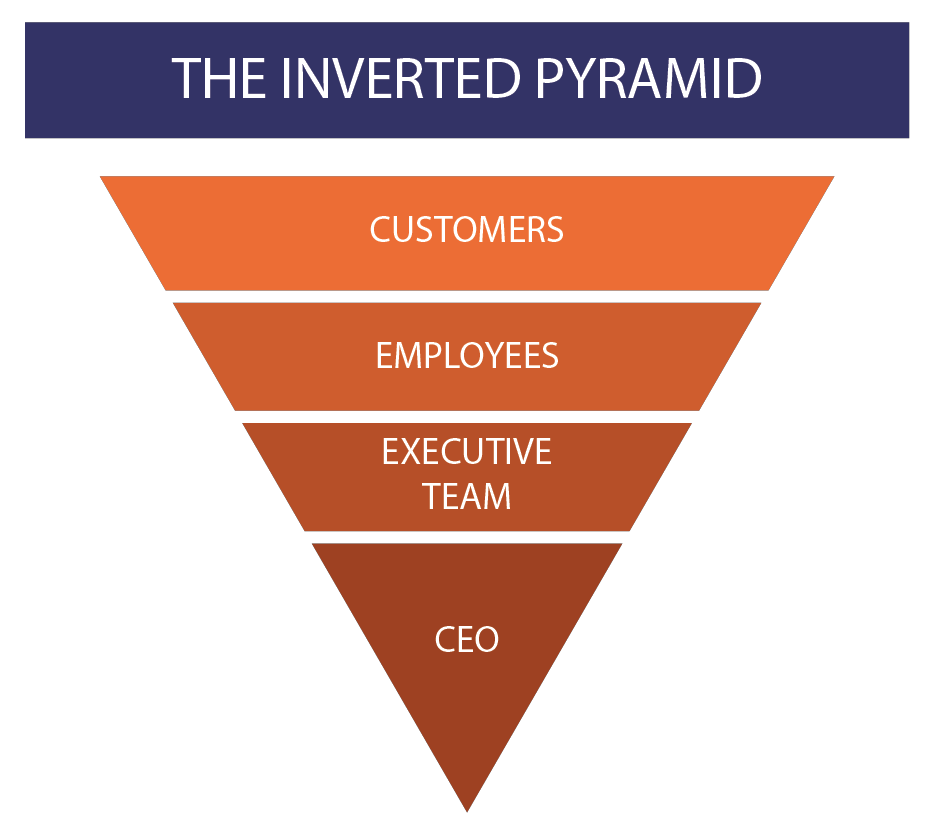Agile Leadership: The Servant Leader
Top-down leadership is outdated and counterproductive. By focusing too much on control and end goals, and not enough on their people, leaders are making it more difficult to achieve their own desired outcomes. The key, then, is to help people feel purposeful, motivated, and energized so they can bring their best selves to work.
One of the best ways is to adopt the humble mind-set of a servant leader. Servant leaders view their key role as serving employees as they explore and grow, providing tangible and emotional support as they do so. They actively seek the ideas and unique contributions of the employees that they serve. This is how servant leaders create a culture of learning, and an atmosphere that encourages followers to become the very best they can.
Essentially what that means is the typical pyramid structure of an organisation with the customers at the bottom, employees above that and CEO at the top needs to be inverted. The customers’ values and opinions are valued above all else, with the frontline workers providing value directly to them. The middle-management and C-level management are simply providing help and value ‘up the chain’ to the internal employees and external customers.
If you are in a traditional leadership position this requires a radical re-think of your role. Here are some practical steps you can take to help switch your leadership style.

Ask how you can help
It sounds deceivingly simple: Rather than telling employees how to do their jobs better, start by asking them how you can help them do their jobs better. The effects of this approach can be powerful.
You are empowering your employees to think critically about their actions and how they impact the customer. You might find that some of the so-called “mistakes” that your employees are making are actually innovations they have created to streamline processes and still deliver everything on time, innovations that if applied across all employees will help the company deliver better customer service.
What it comes down to is this: employees who do the actual work of your organization often know better than you how to do a great job. Respecting their ideas and encouraging them to try new approaches to improve work, encourages employees to bring more of themselves to work.

Create low-risk spaces for employees to think of new ideas
Sometimes the best way for leaders to serve employees — and their organization — is to create a low-risk space for employees to experiment with their ideas. By doing so, leaders encourage employees to push on the boundaries of what they already know.
In the Enterprise Excellence podcast, Brad Jeavons speaks about a leader at BHP who introduced ‘Tim Tam Tuesday’ on his site. Every Tuesday he would take a packet of Tim Tam biscuits, sit down in the lunchroom, and invite his employees to come and have a chat. In this way he was creating a space where he was open with his time and making it plain that he was open to ideas from his frontline workers.
These kinds of experiments pay off in terms of company performance. Employee retention increases, as well as morale and productivity. A culture of continuous improvement is created within the whole organisation, from factory floor to C-level workers.

Be humble
To put it bluntly, servant-leaders have the humility, courage, and insight to admit that they can benefit from the expertise of others who have less power than them. They actively seek the ideas and unique contributions of the employees that they serve. This is how servant leaders create a culture of learning, and an atmosphere that encourages followers to become the very best they can.
Humility and servant leadership do not imply that leaders have low self-esteem or take on an attitude of servility. Instead, servant leadership emphasizes that the responsibility of a leader is to increase the ownership, autonomy, and responsibility of followers — to encourage them to think for themselves and try out their own ideas.
Leaders often do not see the true value of their charges, especially “lower-level” workers. But when leaders are humble, show respect, and ask how they can serve employees as they improve the organization, the outcomes can be outstanding. And perhaps even more important than better company results, servant leaders get to act like better human beings.